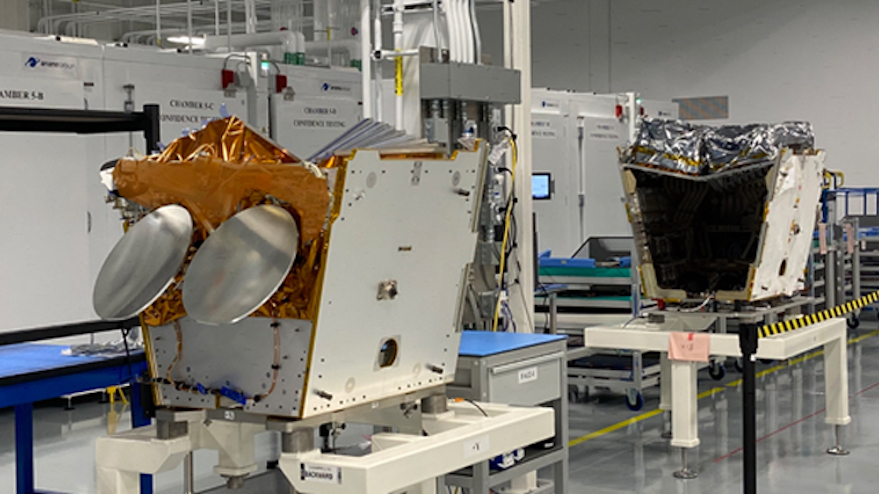
WASHINGTON — With OneWeb’s drive to cover the globe with hundreds of mass-produced satellites halted by last month’s Chapter 11 filing, some of the bankrupt megaconstellation’s component suppliers are looking to repurpose the investments they made in expanded manufacturing capabilities.
Many of OneWeb’s suppliers began working on hardware several years ago for what was expected to be a constellation of 600 to 900 small broadband satellites. Those companies scaled up to meet the two-satellite-a-day production rate targeted by OneWeb Satellites, the OneWeb-Airbus joint venture created to build OneWeb’s constellation.
When OneWeb filed for bankruptcy March 27 after launching just 74 satellites, it left suppliers in a state of limbo. Most of those suppliers have contracts with OneWeb Satellites, which though not bankrupt, did furlough an unspecified number of its 200 employees, according to The Orlando Sentinel. OneWeb Satellites cited the coronavirus, not the bankruptcy of its anchor customer, as the reason for the furloughs.
OneWeb Satellites suppliers interviewed by SpaceNews said they don’t know what, if any, future opportunities remain with OneWeb, but that they are preparing for whatever happens next.
“The end of the OneWeb project, should that happen, would of course damage our company financials,” said Franck Poirrier, CEO of Sodern, a company that supplies star trackers for OneWeb Satellites.
Sodern shipped 200 of an anticipated 1,800 Auriga star trackers, used to orient satellites in space, to OneWeb, Poirrier said by email. The French company set aside a dedicated production room for its Auriga star trackers, which he said can also be used in other small satellites.
Sodern scaled up Auriga production for OneWeb, but didn’t design the star trackers solely for that constellation, he said.
Poirrier said Sodern and its subcontractors slowed Auriga production, but are ready to pick that work back up on short notice if needed by OneWeb Satellites or other customers.
“OneWeb has been a pioneer which has allowed us to turn Auriga into a robust solution, available to all those interested in small satellites,” he said.
Swiss component supplier Ruag opened a 45,000-square-foot facility in Titusville, Florida, in 2017 to mass produce structures for OneWeb’s 150-kilogram satellites and to fill orders for other customers needing structures for satellites up to 500 kilograms, said Oliver Schiewe, senior vice president of Ruag Space’s spacecraft product group.
The facility can produce enough structures for up to 500 satellites a year, he said. Ruag is still assessing the impact OneWeb’s bankruptcy will have on that plant, Schiewe said by email.
“With our demonstrated production rate of two satellites per day, RUAG Space is in a solid position for future collaboration with other partners, and we will be able to quickly move new products into the market,” Schiewe said.
SolAero Technologies, OneWeb Satellite’s solar array supplier, began working with OneWeb back in 2014 when the startup was a Google-backed project, according to Brad Clevenger, SolAero’s chief executive. A manufacturing contract from OneWeb Satellites followed in 2016, he said by email.
The New Mexico company poured $10 million into expanding its manufacturing facilities, with OneWeb as its anchor customer.
Clevenger said SolAero has the means to build and test up to roughly 60 square meters of solar arrays per month. “Staffing was added consistent with supporting and running the production line,” he said.
SolAero produced proprietary designs for OneWeb that cannot be repurposed for other constellations, Clevenger said. However, the factory expansion SolAero undertook in support of its OneWeb work can be put to new use.
“SolAero has a number of multi-vehicle, integrated product programs that benefit from this production capability,” he said.
SolAero, Ruag and Sodern all declined to state the value of their manufacturing contracts. Of the three, only Ruag was listed in OneWeb’s bankruptcy filing as one of its 30 largest unsecured creditors (for $328,000).
While those three companies have customers besides OneWeb Satellites, other component suppliers may not, Chris Quilty, president of Quilty Analytics, said during a SpaceNews webinar April 7.
“The big concern that we’ve identified is we’ve already got a fairly fragile supplier base here,” Quilty said. “Many of them are single-sourced to Airbus.”
Component suppliers were often pressured by tight deadlines before OneWeb’s bankruptcy, Claude Rousseau, research director at Northern Sky Research, said.
“Many of those are actually quite strained in their production and delivery already,” he said. “[OneWeb’s bankruptcy] will not be looking good for many of them.”
Quilty said some OneWeb vendors could hope to win supplier contracts for Telesat LEO, a constellation expected to number around 300 satellites. SpaceX and Amazon megaconstellations represent less likely opportunities since both companies have expressed a desire to vertically integrate much of their satellite production, he said.

